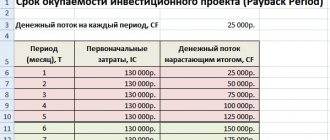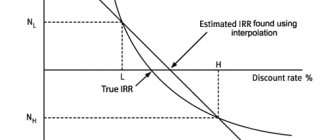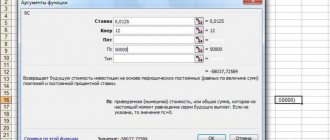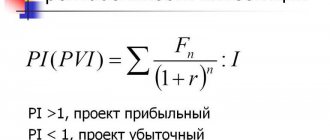Author of the article: Sudakov A.P.
Each investor, investing in a project, is interested in obtaining adequate results from its work. The profitability of an investment can be determined not only based on the results of the financial period, but also at the stage of selecting a subject for cooperation. For the assessment, a special indicator is used, calculated on the basis of information from the financial statements of a business entity that is in the public domain. What is this indicator, what information is needed to calculate it, and how to use it for analysis?
Financial stability indicator
What is the investment coverage ratio
The investment coverage ratio (long-term financial independence ratio) is a financial indicator that gives the analyst an idea of what proportion of an enterprise's assets is financed from sustainable sources (long-term liabilities and equity). You can put it another way - KPI demonstrates the financial stability of the investment object to external influences.
Take our proprietary course on choosing stocks on the stock market → training course
At the same time, long-term liabilities are understood by financial experts as borrowed funds taken from any source with the condition of their repayment no earlier than after 12 months.
Own funds and long-term liabilities are considered sustainable sources of financing for the investment object due to the fact that for at least 1 year they are not used to fulfill current obligations and can be at the full disposal of the enterprise without the need for emergency expenditure.
Important! The investment coverage ratio can confirm the fact that the project is supported by short-term liabilities and/or low-liquid assets - this means that investing financial resources in this business is risky.
Important! The universality of the investment coverage indicator lies in the fact that it is possible to calculate its value having only data from open financial statements. This allows the indicator to be used, for example, by banking institutions when assessing the solvency of potential borrowers and the risk of issuing a loan.
When an applicant applies to a bank for a loan, the credit institution’s analysts assess the stability of the applicant’s enterprise (by the way, the solvency of individuals is checked much faster, but the feasibility of lending to companies is assessed more carefully). Therefore, if the loan was refused, it is possible that the bank’s internal financial experts calculated the investment coverage ratio. The same situation can happen to investors who were ready to invest their money in the development of the enterprise, but changed their minds due to high risks, the presence of which was indicated by the KPI values.
| Business valuation | Financial analysis according to IFRS | Financial analysis according to RAS |
| Calculation of NPV, IRR in Excel | Valuation of stocks and bonds |
First case. A toy shop
Let's say we have a toy store with its own capital, which is the investment of the business founders. Its size is one million rubles. At the same time, the store’s fixed assets, such as premises, furniture, cash register equipment and display cases, cost 5.2 million rubles.
We use the above formula: CI1 = 1/5.2 = 0.192.
Since the resulting investment ratio is less than 0.25, we conclude that the store does not have sufficient financial stability. The store's fixed assets are not sufficiently secured from its own capital. Therefore, theoretically, and perhaps practically, an enterprise may encounter solvency problems or liquidity shortages.
How to calculate the investment coverage ratio (balance sheet formula)
To calculate the value of the investment coverage ratio (relative indicator), you can use the following formula and information from the balance sheet:
The company's equity capital indicator involved in the formula is calculated as follows:
Important! If the company has significant future income (which is reflected in line 1530 of the balance sheet), in order to obtain more accurate calculation results, the amount of equity capital is increased by the amount from line 1530.
It is also possible to calculate using the formula below:
Important! If the investment coverage ratio is calculated for a new business project or a young commercial organization, it is permissible to use financial reporting data for a month or quarter.
You can find out whether the financial result of a business idea covers the funds invested in it by calculating the KPI using the following formula:
How to find out an organization's ability to repay loans?
The ability to fulfill loan obligations can be determined by the debt coverage ratio DSCR (Debt Service Coverage Ratio).
In the current economic situation, it is difficult to run a business without using certain credit injections.
Credit funds are used in the following cases:
- purchase of new equipment;
- increasing the range of products;
- marketing companies;
- project financing;
- daily operations;
- business expansion.
Methods that increase operating income are expensive. Reimbursing the debt with one’s own financial capabilities is difficult and impossible for young organizations. In the process of financial inflow by obtaining loans or attracting investors, each party has its own benefit:
- an increase in the company’s income even taking into account the emerging debt obligations;
- investor's expectation of dividend payment;
- receipt of income from the credit institution from paying interest on the loan.
To receive credit funds, an organization must be financially stable.
Standard values of investment coverage ratio
Once the value of the investment coverage ratio has been found, it is necessary to correctly analyze it. It should be noted right away that the normative value of the KPI remains the same regardless of the scale of activity of a commercial organization and sector of the economy, because we are talking about the firm having a base of stable liabilities to finance assets. So, the decoding of the exact values of the KPI is as follows:
- If the calculation result is less than 0.7-0.8, there is a high probability that the company will not be able to fulfill its obligations to counterparties, since it has resorted to short-term loans and raising other borrowed funds with a short repayment period in order to purchase non-current assets (structures, buildings , equipment, etc.), not capable of instantly generating financial resources. In such a situation, the internal analyst is recommended to immediately start forecasting other solvency indicators in order to find out the degree of financial stability of the company.
- The optimal coefficient value is considered to be in the range from 0.7 to 0.9.
- If the coefficient value is close to one or > 0.9, this means that equity capital and borrowed funds with a long repayment period are able to fully cover the amount of long-term investments in the company’s business activities.
At the same time, it is necessary to take into account two important points in the analysis of the investment coverage ratio:
- if the value of the coefficient is close to the standard value (0.6-0.7), the risk for the investor exists only if the company undergoes truly serious external stress (noticeable fluctuations in the exchange rate, violation of contract terms by counterparties, etc.);
- if the indicator is above 0.9, the business idea (project, company) is considered reliable with the caveat that the company’s management is probably not using loans with a short repayment period effectively enough.
Why is all this calculated?
The investment ratio is necessary to calculate financial stability. It is used to determine the balance of financial flows, which allows the organization to maintain its activities over a long period of time, producing products and servicing received loans. In addition, for this purpose, the coefficients of autonomy, provision of own working capital, reserves, mobility, maneuverability and others can be calculated.
All these indicators are used to predict how easily a company can survive possible difficulties. They may be most affected by leverage. How? It is believed that if they make up more than half of all funds available to a company, then this is not a good sign for its sustainability and future. Although this figure may vary significantly for different industries. So, for trading companies that have a significant turnover, this indicator is much more loyal. In general, that’s all you need to know about the investment ratio.
Example of calculating the investment coverage ratio
As already mentioned, it is more appropriate to analyze efficiency ratios in comparison with the performance indicators of competitors in a similar economic industry or production volume. Let's consider an example of calculating the cash investment coverage ratio by comparing the performance indicators of a large manufacturer of construction equipment, Super-Stroy LLC, and a small intermediary in the wholesale sale of spare parts for loaders and dump trucks, Crane and Bucket LLC.
Let's calculate the investment coverage ratio for the large Super-Stroy LLC (calculations are made in thousands of rubles):
Conclusions: The KPI is growing dynamically (although stable growth is not observed) and by 2021 reaches a value of 0.5890. The optimal value has not been achieved, but this can be expected in the future. Accordingly, if the economic situation is stable, Super Stroy LLC will remain solvent, and the funds invested in it will be returned to investors. However, as soon as the company experiences external stress, a situation close to bankruptcy will arise. This means that when investing in “Super Stroy” in 2017, the investor must prepare himself for certain financial risks.
Now let’s carry out the same analysis in relation to the small reseller Crane and Bucket LLC:
Conclusions: Stable sources of financing (equity and long-term debt) amounted to only 49-56% of the company’s total capital over 3 years of activity. The obtained KPI values indicate that Crane and Bucket LLC carries out business activities at a high level of risk. Large sums from the budget are spent on fulfilling short-term obligations (namely, on repaying the “body” of loans with a short repayment period and interest on them). There is an increase in the volume of own funds and borrowed money on loans whose repayment period exceeds 12 months.
General conclusion: The indicators of both analyzed enterprises are incomparable with the standard KPI values, which means that both companies have a certain risk of bankruptcy in the future. This is typical for Russian entrepreneurship, because... Banking institutions, insuring themselves against non-payment of loans, issue short-term loans to borrowers more often than long-term loans. Probably, during the economic crisis of 2014-2015, Super Stroy LLC and Crane and Bucket LLC took out short-term loans, but their situation improved over the next 2 years. However, the largest manufacturer of construction equipment is characterized by the greatest financial stability.
Standard indicator
The normal COP value is from 1.5 to 2.5. For different sectors of the economy, the standard shifts in one direction or another, but remains close to these figures. The lower the value, the worse the solvency situation. A coefficient equal to 1 characterizes financial insolvency and problems with paying current bills. If the indicator is more than 3, then this indicates an inefficient capital structure, in which part of the funds does not work.
| Less than 1.5 | 1,5-2,5 | More than 2.5 |
| Asset liquidity problems | The solvency of the enterprise is within normal limits | High solvency |
| The company cannot be liable for short-term obligations | Current bills are paid on time | Irrational capital structure |
| Delays in current payments | The company has no problems with the sale of assets | Less risks with the sale of assets |
| Difficulties in selling assets | Optimal capital structure | Timely payment of bills |
| Profits go to pay off debts | Profit is rationally distributed | Profit is completely deferred |
Important! The ratio does not in any way characterize the cash flow of the enterprise.
Despite the fact that exceeding the norm also refers to management deficiencies, it is better than having an indicator value that is too low. In this case, it is possible to find additional opportunities for growth and development by redistributing the assets of the enterprise. And with a low ratio, all that remains is to attract additional sources of financing or make radical decisions on the further work of the company (redefining activities, cutting costs, narrowing the range of products produced/sold, etc.).
A CPI value of less than 1 indicates the financial insolvency of the company and the possibility of near bankruptcy. In this case, it is necessary to take measures to save the enterprise.
Questions and answers on the topic
No questions have been asked about the material yet, you have the opportunity to be the first to do so
Example of calculating KPI for investment purposes
A modern restaurant and auto manufacturing company is opening in Moscow. The investor is faced with a choice - where to invest free funds in order to get the greatest benefit. Basic information about the financing of the activities of these two companies at the opening stage is presented in the table below:
| Investments in a young enterprise | Amount for a restaurant (thousand rubles) | Amount for a car company (thousand rubles) |
| The owners took out a bank loan with a long payment period | 6 000 | 6 000 |
| Fixed capital of the establishment (premises, furniture, tools, equipment, etc.) | 24 000 | 32 000 |
| Own capital (investments of owners) | 10 000 | 24 000 |
| Total financial investment required to open | 16 000 | 20 000 |
From the analysis of the indicator for a new restaurant, it becomes clear that the KPI is far from optimal values. But the indicators for the auto company are more than optimistic. Therefore, the investor decides to invest in opening an automobile enterprise, because... this choice is less risky.
Return on invested capital
Definition. Return on invested capital is the return on a certain amount of money invested in a business or project. All other indicators can be considered derivatives of ROI, only the investment base for them is the corresponding parts of the liabilities or assets of the enterprise. For example, ROE is also called ROI of shareholders (stockholder's return on investment), since this indicator evaluates the return on the equity capital invested in the enterprise.
Example. The equity capital (funds) of the enterprise at the beginning of the year amounted to 589 million rubles, at the end of the year 623 million rubles. Long-term liabilities: 17.5 million rubles and 21.81 million rubles. Net profit is 131.76 and 153.8 million rubles, respectively. Determine the change in the return on assets ratio for the year.
Answers to frequently asked questions on the topic “Investment coverage ratio”
Question: Is the investment coverage ratio used when assessing the probability of bankruptcy?
Answer: Yes, KPI is calculated, among other things, to assess the likelihood of bankruptcy and failure of a business idea. As a rule, for this purpose, this indicator is calculated in conjunction with the current liquidity indicator.
Question: The result of which analysis will be more accurate: studying the investment coverage ratio separately or studying the KPI together with some other indicators?
Answer: It is preferable to analyze the investment coverage ratio together with the solvency and liquidity ratios.
| Business valuation | Financial analysis according to IFRS | Financial analysis according to RAS |
| Calculation of NPV, IRR in Excel | Valuation of stocks and bonds |











